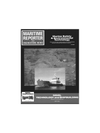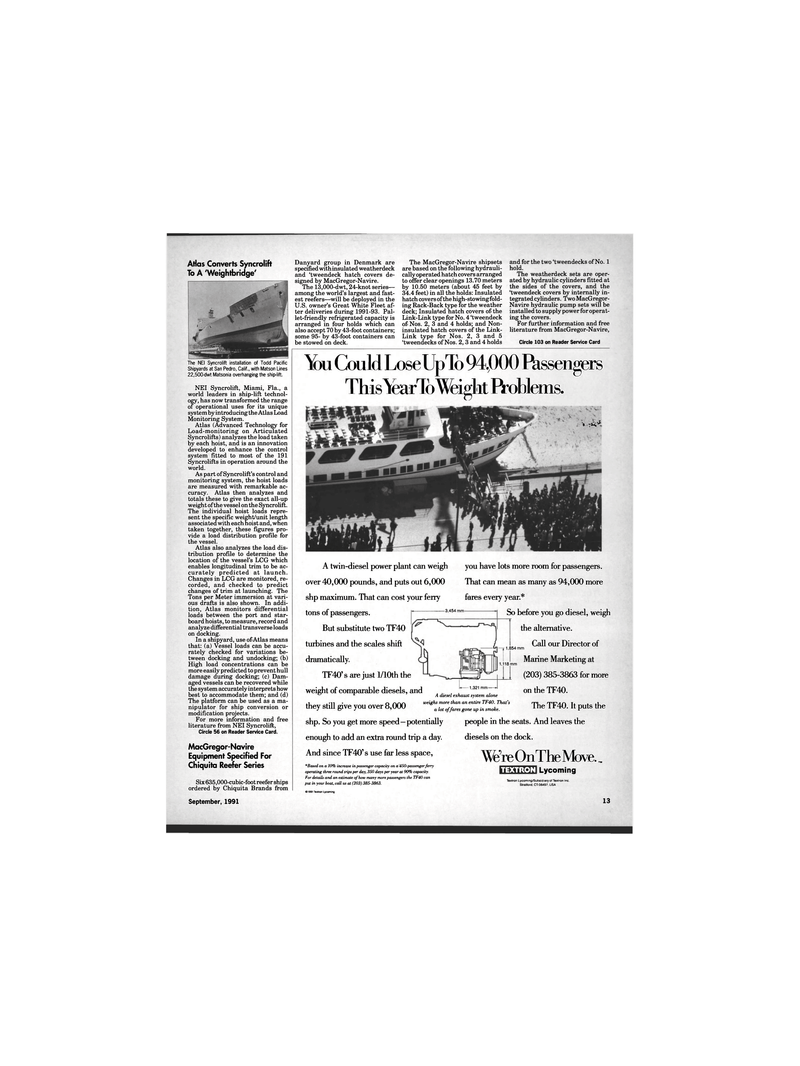
Page 12: of Maritime Reporter Magazine (September 1991)
Read this page in Pdf, Flash or Html5 edition of September 1991 Maritime Reporter Magazine
Atlas Converts Syncrolift
To A 'Weightbridge'
The NEI Syncrolift installation of Todd Pacific
Shipyards at San Pedro, Calif., with Matson Lines 22,500-dwt Matsonia overhanging the ship-lift.
NEI Syncrolift, Miami, Fla., a world leaders in ship-lift technol- ogy, has now transformed the range of operational uses for its unique system by introducing the Atlas Load
Monitoring System.
Atlas (Advanced Technology for
Load-monitoring on Articulated
Syncrolifts) analyzes the load taken by each hoist, and is an innovation developed to enhance the control system fitted to most of the 191
Syncrolifts in operation around the world.
As part of Syncrolift's control and monitoring system, the hoist loads are measured with remarkable ac- curacy. Atlas then analyzes and totals these to give the exact all-up weight of the vessel on the Syncrolift.
The individual hoist loads repre- sent the specific weight/unit length associated with each hoist and, when taken together, these figures pro- vide a load distribution profile for the vessel.
Atlas also analyzes the load dis- tribution profile to determine the location of the vessel's LCG which enables longitudinal trim to be ac- curately predicted at launch.
Changes in LCG are monitored, re- corded, and checked to predict changes of trim at launching. The
Tons per Meter immersion at vari- ous drafts is also shown. In addi- tion, Atlas monitors differential loads between the port and star- board hoists, to measure, record and analyze differential transverse loads on docking.
In a shipyard, use of Atlas means that: (a) Vessel loads can be accu- rately checked for variations be- tween docking and undocking; (b)
High load concentrations can be more easily predicted to prevent hull damage during docking; (c) Dam- aged vessels can be recovered while the system accurately interprets how best to accommodate them; and (d)
The platform can be used as a ma- nipulator for ship conversion or modification projects.
For more information and free literature from NEI Syncrolift,
Circle 56 on Reader Service Card.
MacGregor-Navire
Equipment Specified For
Chiquita Reefer Series
Six 635,000-cubic-foot reefer ships ordered by Chiquita Brands from
September, 1991
Danyard group in Denmark are specified with insulated weatherdeck and 'tweendeck hatch covers de- signed by MacGregor-Navire.
The 13,000-dwt, 24-knot series— among the world's largest and fast- est reefers—will be deployed in the
U.S. owner's Great White Fleet af- ter deliveries during 1991-93. Pal- let-friendly refrigerated capacity is arranged in four holds which can also accept 70 by 43-foot containers; some 95- by 43-foot containers can be stowed on deck.
The MacGregor-Navire shipsets are based on the following hydrauli- cally operated hatch covers arranged to offer clear openings 13.70 meters by 10.50 meters (about 45 feet by 34.4 feet) in all the holds: Insulated hatch covers of the high-stowing fold- ing Rack-Back type for the weather deck; Insulated hatch covers of the
Link-Link type for No. 4 'tweendeck of Nos. 2, 3 and 4 holds; and Non- insulated hatch covers of the Link-
Link type for Nos. 2, 3 and 5 'tweendecks of Nos. 2, 3 and 4 holds and for the two 'tweendecks of No. 1 hold.
The weatherdeck sets are oper- ated by hydraulic cylinders fitted at the sides of the covers, and the 'tweendeck covers by internally in- tegrated cylinders. Two MacGregor-
Navire hydraulic pump sets will be installed to supply power for operat- ing the covers.
For further information and free literature from MacGregor-Navire,
Circle 103 on Reader Service Card
Yoa Could LoseUpTo94,000 Passengers
This^earlo^feiglit Problems. > -tM
A twin-diesel power plant can weigh over 40,000 pounds, and puts out 6,000 shp maximum. That can cost your ferry tons of passengers.
But substitute two TF40 turbines and the scales shift dramatically.
TF40's are just l/10th the 3,454 mm weight of comparable diesels, and they still give you over 8,000 shp. So you get more speed—potentially enough to add an extra round trip a day.
And since TF40's use far less space, *Based on a 10% increase in passenger capacity on a 450-passenger ferry operating three round trips per day, 350 days per year at 90% capacity.
For details and an estimate of how many more passengers the TF40 can put in your boat, call us at (203) 385-3863. ©1991 Textron Lycoming you have lots more room for passengers.
That can mean as many as 94,000 more fares every year.*
So before you go diesel, weigh the alternative.
Call our Director of 1,854 mm 1,118mm
Marine Marketing at 1,321 mm—
A diesel exhaust system alone weighs more than an entire TF40. That's a lot of fares gone up in smoke. (203) 385-3863 for more on the TF40.
The TF40. It puts the people in the seats. And leaves the diesels on the dock.
We're OnThe Move. TU
TEXTRON Lycoming
Textron Lycoming/Subsidiary of Textron Inc.
Stratford, CT 06497, USA 13

 11
11

 13
13
